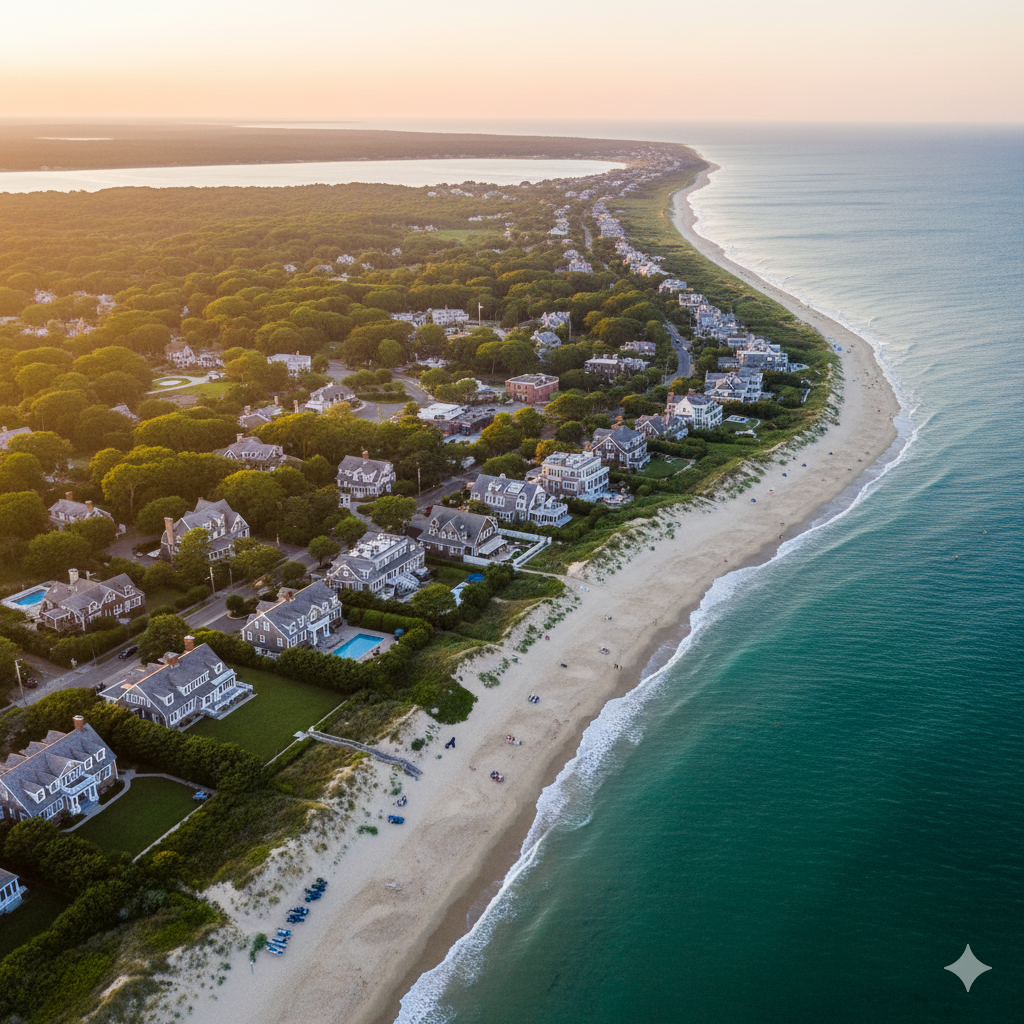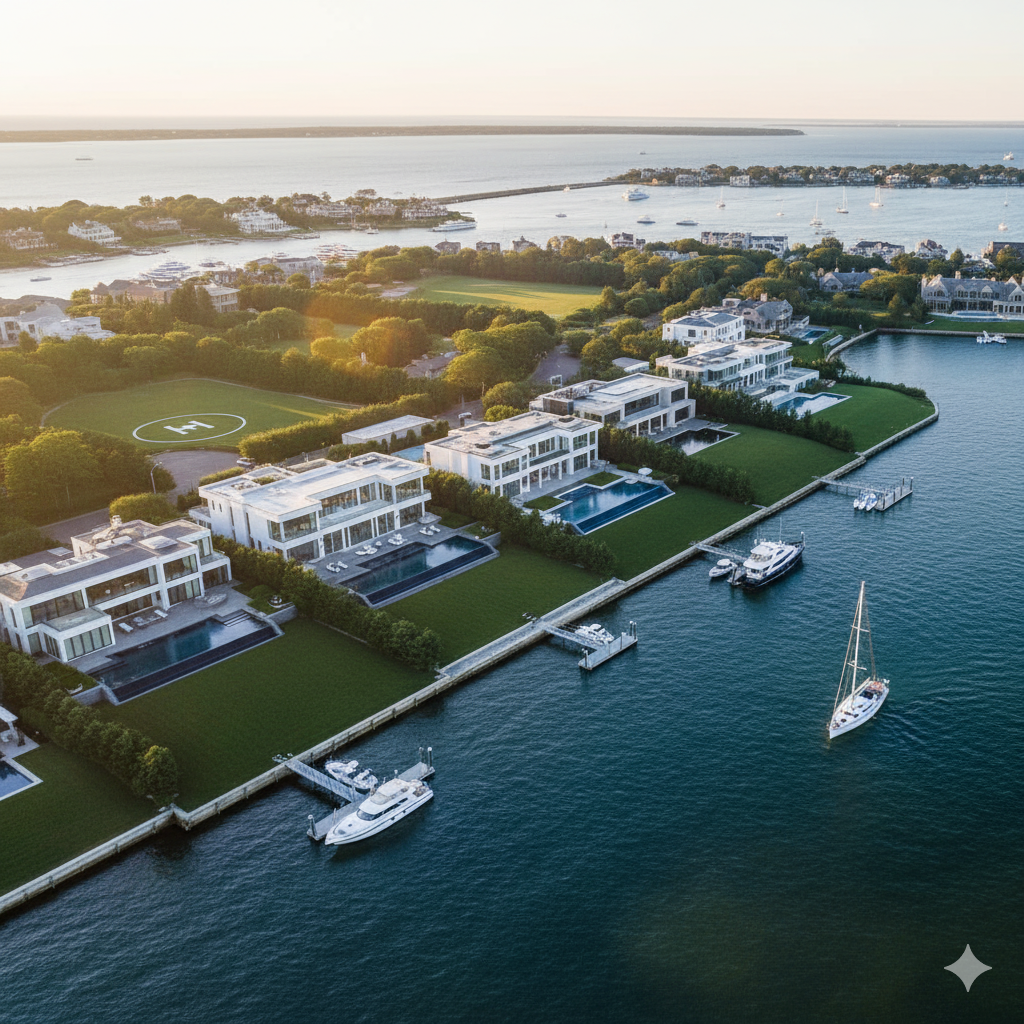The Last Hamptons Village That Still Feels Like a Secret
There’s something almost criminal about how Amagansett has managed to stay hidden. While East Hampton plays dress-up for cameras and Montauk throws its summer tantrums, this 6.6-square-mile hamlet operates like a Swiss bank vault of privilege. Consequently, it remains quiet. Moreover, it stays discreet. Ultimately, it becomes absolutely lethal to your bank account once you understand what you’re looking at.
The Amagansett Advantage: Why Smart Money Moves Here
First, walk down Meadow Lane in Southampton, and you’ll witness a nine-figure arms race. However, drive through Amagansett, and you’ll discover something rarer than a $100 million listing: authenticity at scale. Current median prices hit $5.0 million, yet the real value isn’t captured in Redfin’s algorithms.
Specifically, consider this: Amagansett attracts buyers who could afford Southampton’s Billionaire Lane but choose different math. Instead, they’re buying access to Indian Wells Beach without the performance art.
Similarly, they want the Stephen Talkhouse, not the club that replaced it. Furthermore, they understand that scarcity drives appreciation, and Amagansett offers something Southampton can’t manufacture: restraint.
Importantly, the calculation is elegant. Initially, oceanfront properties here provide the same Atlantic access as their Southampton counterparts. Meanwhile, Southampton’s Billionaire Lane operates as a status signaling device first, residence second. Conversely, Amagansett residents signal differently: they don’t.
Market Dynamics: The Numbers Behind the Mystique
Furthermore, current market data reveals fascinating contradictions. September 2025 showed median prices of $5.0 million, down 11.6% year-over-year. Additionally, inventory moves slower than in flashier markets. Consequently, properties spend 89 days on market versus 60 in Southampton.
Reading Between the Lines: What Declining Prices Really Mean
However, smart buyers read these numbers differently. First, the price decline reflects broader Hamptons cooling, not Amagansett-specific weakness. Second, longer market times create negotiation leverage for qualified buyers. Third, reduced competition from speculative investors opens opportunities for serious wealth builders.
Migration Patterns: Who’s Moving to Amagansett and Why
Moreover, the migration patterns tell a deeper story. Los Angeles, Honolulu, and Montgomery buyers search Amagansett more than any other markets. Meanwhile, 69% of current buyers seek to stay within the metropolitan area. Therefore, this suggests both coastal wealth migration and local appreciation.
The Devon Colony Phenomenon: Old Money’s Original Playbook
To understand Amagansett’s real estate DNA, study the Devon Colony. Founded in 1908 by Cincinnati business titans—including Procter & Gamble’s William Cooper Procter—this 1,000-acre enclave pioneered the Hamptons’ gated community concept.
The Strategic Foundation: How Visionaries Built Value
Initially, the Colony’s founders acquired vast acreage in Amagansett’s highlands for hunting expeditions. Subsequently, they built grand stucco mansions as summer retreats.
Meanwhile, local aristocrats initially sneered at “Soap Hill,” yet the Colony’s isolation strategy proved brilliant. Today, Devon Colony properties command premium pricing while maintaining their founder’s vision: privacy through land control.
Lessons for Modern Investors: The Devon Colony Strategy
Clearly, modern buyers should study this playbook. First, purchase maximum acreage. Then, build thoughtfully. Finally, preserve natural barriers. As a result: appreciation through scarcity, not flash.
Architectural Character: Where History Meets Investment Logic
Notably, Amagansett’s built environment tells two stories: preservation and adaptation. Authentic 18th and 19th-century homes stand alongside contemporary masterpieces. Consequently, this architectural diversity creates multiple price points within premium geography.
Historic Properties vs. New Construction: Investment Considerations
On one hand, historic properties offer immediate character but often require significant renovation investment. On the other hand, new construction provides modern amenities while respecting traditional aesthetics. Therefore, smart buyers recognize both paths as viable, depending on timeline and risk tolerance.
Regulatory Protection: How Zoning Preserves Value
Most importantly, the key insight: Amagansett’s building codes favor preservation over maximization. Furthermore, this regulatory environment protects existing owners’ investment while limiting new supply. As a result: steady appreciation without overdevelopment’s boom-bust cycles.
Geographic Advantages: Natural Scarcity Meets Strategic Location
Clearly, Amagansett’s geography creates inherent investment protection. The hamlet sits between East Hampton and Montauk, bounded by Atlantic Ocean and Napeague Bay. Additionally, significant preserved land—including nature conservancy holdings—prevents overdevelopment.
Transportation Excellence: Access Without Overwhelm
Meanwhile, transportation access remains excellent without overwhelming traffic. Specifically, the Long Island Rail Road provides direct Manhattan connection. Furthermore, East Hampton Airport sits minutes away for private aviation. Most importantly, Amagansett avoids the bottleneck traffic that plagues other Hamptons destinations.
Beach Access: World-Class Oceanfront Without the Crowds
Similarly, beach access represents another competitive advantage. Indeed, Indian Wells Beach and Atlantic Avenue Beach offer world-class oceanfront without Southampton’s crowds. Moreover, Amagansett National Wildlife Refuge and Atlantic Double Dunes Preserve provide permanent green space between beaches.
The Celebrity Factor: Fame Without the Circus
Notably, Amagansett attracts boldface names who understand discretion’s value. Paul McCartney, Jerry Seinfeld, Scarlett Johansson, and Alec Baldwin maintain properties here. Additionally, Marilyn Monroe and Arthur Miller famously summered in the village during the late 1950s.
However, celebrity presence operates differently than in East Hampton or Southampton. Instead, stars blend into local fabric rather than dominating it.
Consequently, this cultural norm preserves the village character that originally attracted them. Furthermore, it signals to potential buyers that Amagansett prioritizes substance over spectacle.
Therefore, for investors, celebrity endorsement provides valuable validation without market distortion. Ultimately, properties gain cachet without pricing bubbles driven by paparazzi attention.
Investment Timing: Reading Market Signals Like an Insider
Currently, market conditions create compelling entry opportunities for qualified buyers. Price softening combined with inventory availability suggests optimal purchasing window.
Market Factors Supporting Strategic Entry
Specifically, several factors support this thesis. First, mortgage rates above 6% reduce financed competition. Second, reduced speculative buying eliminates bidding wars.
Third, motivated sellers provide negotiation leverage. Finally, infrastructure improvements—including improved internet connectivity—enhance work-from-home appeal.
The Patient Capital Advantage
Ultimately, smart money recognizes these cycles. Purchase during market lulls. Then, hold through appreciation phases. Finally, sell into strength. Amagansett real estate rewards patient capital with steady returns plus lifestyle dividends.
Due Diligence Essentials: What Experienced Buyers Check First
Importantly, successful Amagansett acquisitions require specialized knowledge. Initially, flood zones affect certain coastal properties, requiring proper insurance evaluation.
Additionally, septic systems demand inspection given limited municipal services. Furthermore, well water quality varies significantly across the hamlet.
Moreover, zoning restrictions deserve careful study. Specifically, historic district requirements may limit renovation options.
Meanwhile, wetland buffers can affect buildable area calculations. Therefore, environmental assessments should include soil contamination testing given agricultural history.
Finally, title research proves especially important given the area’s complex ownership history. Indeed, some properties retain historic easements or usage rights.
Consequently, professional legal review prevents costly surprises during closing or future development planning.
The Cultural Economy: Why Lifestyle Supports Investment
Significantly, Amagansett’s cultural infrastructure justifies premium pricing while attracting desirable demographics. The Stephen Talkhouse draws world-class musical talent to an intimate venue. Meanwhile, local galleries, artisan shops, and farmers’ markets create year-round activity.
Furthermore, the village maintains authentic character without sacrificing sophistication. For instance, Jack’s Stir Brew provides excellent coffee alongside village gossip.
Similarly, Christian’s by Wölffer offers refined dining without reservation politics. Additionally, Amagansett Square creates community gathering space that encourages local connections.
Consequently, this cultural balance attracts buyers seeking substance over flash. Indeed, they want neighbors, not audiences. Amagansett real estate delivers both premium location and authentic community—a combination increasingly rare in luxury markets.
Future Outlook: Sustainability Meets Luxury Demand
Clearly, Amagansett’s long-term prospects benefit from several macro trends. Notably, remote work capabilities reduce location constraints for high earners.
Similarly, climate considerations favor northern coastal areas over southern alternatives. Additionally, preservation policies protect natural beauty that drives luxury demand.
Moreover, infrastructure investments support continued appreciation. For example, improved broadband enables remote work flexibility.
Likewise, road improvements reduce Manhattan commute times. Furthermore, renewable energy initiatives align with environmental consciousness among target demographics.
Ultimately, the hamlet’s commitment to controlled growth ensures appreciation without overdevelopment risks. Therefore, this balanced approach protects existing investment while allowing measured expansion.
Consequently, smart buyers recognize this sustainability model as luxury real estate’s future direction.
Conclusion: The Last Secret Worth Keeping
Ultimately, Amagansett represents something increasingly precious in modern luxury markets: authenticity at scale. While other Hamptons destinations chase headlines and Instagram followers, this hamlet operates according to different principles.
Quality over quantity. Similarly, substance over spectacle. Finally, long-term value over short-term gains.
Importantly, the numbers support the narrative. Amagansett real estate provides oceanfront access, cultural richness, and investment appreciation without sacrificing the character that created value initially.
Furthermore, current market conditions create compelling entry opportunities for qualified buyers who understand the difference between price and value.
Indeed, in a world where luxury increasingly means performance art, Amagansett offers something rarer: the luxury of being left alone. That’s not just good living. Ultimately, it’s smart money.
Related Stories
Connect With Social Life Magazine







